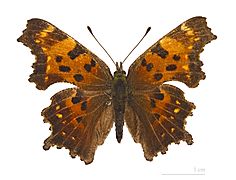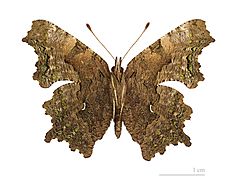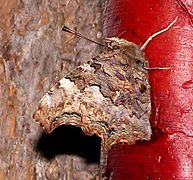Green comma facts for kids
Quick facts for kids Green comma |
|
|---|---|
 |
|
| On silver fir, Washington, U.S. | |
| Conservation status | |
| Scientific classification | |
| Synonyms | |
|
The green comma butterfly, scientifically known as Polygonia faunus, is a fascinating insect. It's also called the Faunus comma or Faunus anglewing because of its unique wing shape. This butterfly belongs to the Nymphalidae family, which includes many well-known butterflies like monarchs and painted ladies.
Contents
Green Comma Subspecies
Scientists sometimes divide the green comma butterfly into different groups called subspecies. These groups are often named based on slight differences in their appearance or where they live.
Some of the recognized subspecies include:
- Polygonia faunus smythi
- Polygonia faunus faunus
- Polygonia faunus articus
- Polygonia faunus rusticus (which tends to be brown and lives in the west)
- Polygonia faunus hylas (which is often gray and found in the Rockies)
Even though some experts see these as distinct subspecies, many others consider them to be just regional variations. This means they are slightly different versions of the same butterfly, adapted to their local environment.
Where Green Commas Live and What They Like
You can find the green comma butterfly across a large part of North America. They live from central Alaska all the way south to central California and northern New Mexico. They are also found near the Great Lakes area, stretching to New England and the Maritimes in Canada. You might even spot them in the southern Appalachian Mountains.
These butterflies prefer to live in forests and mountain woodlands. They often hang out near streams and in canyons. Their favorite places are usually cool and shady.
What Does the Green Comma Look Like?
The green comma butterfly has a wingspan that can be about 45 to 64 millimeters (about 1.8 to 2.5 inches) wide. One of their most noticeable features is their very ragged or torn-looking wing edges. This unique shape helps them blend in with leaves.
Their appearance can vary quite a bit depending on where they live.
- The top side of their wings is usually a reddish-brown color with wide, dark borders.
- The back wings have a row of yellow spots along the border.
- The underside of their wings is grey-brown. The outer half is lighter and has greenish spots that look like lichen. This helps them camouflage when their wings are closed.
- Male green commas have these greenish spots.
- Female green commas have wings that are more uniformly dull gray on the underside.
- Both males and females have a special L or C-shaped silver spot in the middle of their hindwings.
Similar Butterflies
The green comma butterfly looks a lot like the eastern comma (P. comma). However, you can usually tell them apart by the green comma's more irregular wing edges and the row of green spots on the underside of its wings.
Scientists also see a strong connection between the green comma and the comma butterfly (Polygonia c-album). They are related within the same genus, Polygonia.
However, there's a key difference between the Polygonia species in North America and Polygonia c-album. North American green commas usually live in cooler areas and only have one generation of butterflies each year. They also don't change their appearance much with the seasons. The Polygonia c-album butterfly, on the other hand, can live in milder regions, have more generations, and show different forms depending on the season.
Green Comma Life Cycle and Habits
Female green comma butterflies lay their eggs on the top surface of the leaves of certain plants. The caterpillars, which are solitary (meaning they live alone), eat leaves from a variety of host plants.
Some of their favorite food plants include:
- Upland willow (Salix humilis)
- Betula lenta (a type of birch tree)
- Alder trees
- Rhododendron occidentale
- Ribes species (like currants and gooseberries)
They have also been seen eating from:
- Nettles (Urtica species)
- Hops (Humulus species)
- Elm (Ulmus species)
- Azalea (Rhododendron species)
These butterflies typically have only one generation per year, which is called univoltine. They are usually seen flying from May to September, depending on exactly where they live. Adult butterflies will spend the winter months in a hidden spot and then emerge again the following spring.
Gallery





